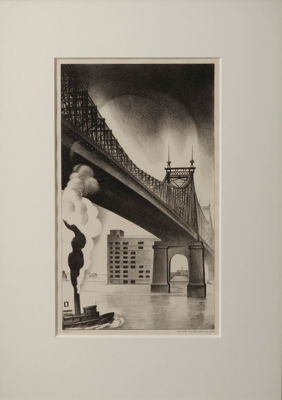Louis Lozowick
Title: Bridge Repairs
Lozowick is renowned for his Precisionist style with his lithographs, influenced in part from his travels through Berlin and Moscow and associations with styles such as Russian Constructivism, Bauhaus, Futurism and De Stijl, and contact with artists such as El Lissitsky. The sharp, geometrically inclined murals focus heavily on the repeating forms and patterns of mechanised industry and the urban environment, but convey humanist principles and an ultimately optimistic view of industrial progression and the human condition within 1930s New York.
Title: Mid-Air
Lozowick is renowned for his Precisionist style with his lithographs, influenced in part from his travels through Berlin and Moscow and associations with styles such as Russian Constructivism, Bauhaus, Futurism and De Stijl, and contact with artists such as El Lissitsky. The sharp, geometrically inclined murals focus heavily on the repeating forms and patterns of mechanised industry and the urban environment, but convey humanist principles and an ultimately optimistic view of industrial progression and the human condition within 1930s New York.
Title: Mural Study-Triborough Bridge
Lozowick is renowned for his Precisionist style with his lithographs, influenced in part from his travels through Berlin and Moscow and associations with styles such as Russian Constructivism, Bauhaus, Futurism and De Stijl, and contact with artists such as El Lissitsky. The sharp, geometrically inclined murals focus heavily on the repeating forms and patterns of mechanised industry and the urban environment, but convey humanist principles and an ultimately optimistic view of industrial progression and the human condition within 1930s New York.
Title: Queensborough bridge
Lozowick is renowned for his Precisionist style with his lithographs, influenced in part from his travels through Berlin and Moscow and associations with styles such as Russian Constructivism, Bauhaus, Futurism and De Stijl, and contact with artists such as El Lissitsky. The sharp, geometrically inclined murals focus heavily on the repeating forms and patterns of mechanised industry and the urban environment, but convey humanist principles and an ultimately optimistic view of industrial progression and the human condition within 1930s New York.





